| Hurricane Warnings in Effect | Atlantic: High Seas |
OPC's Radiofacsimile Charts User's Guide
This User's Guide provides an outline of Marine fax products, their descriptions, and how to use them. It is also available in PDF format (~2.3 MB).
Table of Contents
Introduction to Ocean Prediction Center's (OPC) Radiofacsimile Program500 MB Products
500-mb Analyses
24-Hour 500-mb Forecasts
36-Hour 500-mb Forecasts
48-Hour 500-mb Forecasts
96-Hour 500-mb Forecasts
Surface Products
Surface Analysis
24-Hour Surface Forecast
48-Hour Surface Forecast
72-Hour Surface Forecast
96-Hour Surface Forecast
Sea State Products
Sea State Analysis
48-Hour Wind & Wave Forecast
48-Hour and 96-Hour Wave Period & Direction/Ice Accretion Forecast
Regional Products
Regional Sea State Analysis
Ocean Prediction Center's OFB Atlantic and Pacific Radiofacsimile Schedules
Description of National Hurricane Prediction Center's (NHC) Radiofacsimile Program
Ocean Prediction Center Radiofacsimile Program
The National Weather Service (NWS) has the responsibility for issuing warnings and forecasts to protect life and property in the maritime community. The area of responsibility covers most of the North Atlantic and North Pacific N of 30N with graphical products covering the marine areas S to 15N. Most of these products are in graphical format and prepared by the NWS's National Centers For Enviromental Prediction (NCEP) by its Ocean Prediction Center (OPC). The Ocean Forecast Branch (OFB) a unit of OPC at College Park, MD, near Washington D.C. is responsible for the issuance of various marine products. These products are distributed by high-frequency (HF) Radiofacsimile broadcast via the US Coast Guard Communications Centers at Boston, MA, and Pt Reyes, CA, for the North Atlantic and North Pacific Oceans, respectively. Also, these products are available on the internet on the Ocean Prediction Center's Home Page.
High Seas Products
Vessels engaged in national and international trade routinely conduct transoceanic voyages with fast turn around times between ports of call. Ships require timely and accurate presentation of meteorological and oceanographic information for a large geographical area to plan for safe and economical operations. This information is most user friendly when presented in graphic form. The OPC recognizes HF Radiofacsimile as the most widely used medium by ships for receipt of graphically displayed environmental analyses and forecasts.
The following suite of products addresses the common needs and requirements of professional mariners engaged in transoceanic crossings and offers the maritime community complete and timely graphic products to support navigation safety and operating efficiency. Three primary types of products are issued: upper air 500 millibar (mb) charts, surface pressure, and sea state charts. Additional charts include sea surface temperatures (SST), tropical streamline and surface analyses, and meteorological satellite imagery. Users whose specific or specialized requirements for high seas information are not met by these general safety-oriented products are referred to the private meteorological and oceanographic sector for assistance.
Base Maps
There are two types of base maps. The larger scale ocean base map is a mercator projection and has latitude and longitude marked in 10 degree increments. The second type of base map is the regional which encompasses the west and east coasts of the US covering subsections of the Atlantic and Pacific high seas areas in the mercator projection. In addition the regional Pacific has a polar stereographic which is for the Alaska region.
Upper Air 500-MB Products
The 500-mb charts are produced from a computer model of the atmosphere. These products are automated unmodified computer outputs that depict height contours above the earth's surface (geopotential heights) at 60 meter intervals. Wind speeds of 30 knots and greater are shown with wind barb increments of 5 or 10 knots. Embedded within the 500-mb height field are short wave troughs, generally 50 degrees or less in longitude. These are drawn on the charts as bold dashed lines. These short wave troughs will assist the mariner in locating surface low pressure systems or developing lows on frontal waves. The 500-mb winds approximate the speed of motion of surface extra-tropical lows (often about 1/3 to 1/2 of the 500-mb wind speed) and surface wind force (approximately 50 percent), particularly in the colder SW quadrant. The 5640 meter height contour is highlighted since this height contour is widely used by the professional mariner for general surface storm track direction and the southern extent of Beaufort Force 7 (28-33 knot) or greater surface winds in the winter, and force 6 (22-27 knot) winds in summer. The 500-mb products are not intended to be used alone. The mariner is strongly advised to examine other Radiofacsimile products described in this User's Guide in order to derive a complete picture of weather and sea state conditions.
500-mb Analyses
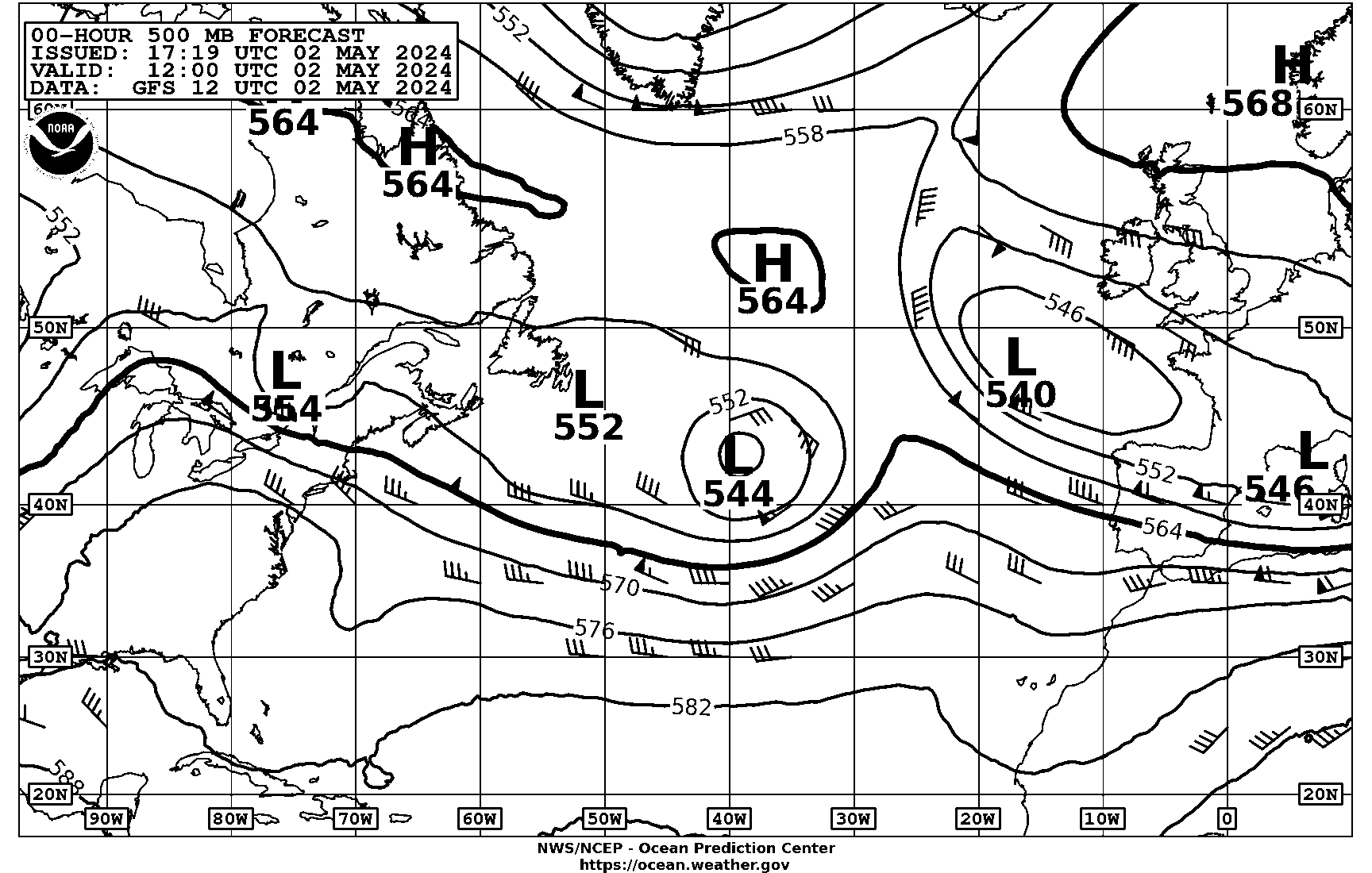
These analyses are generated twice a day for 00Z and 12Z. They depict synoptic scale flow patterns, location, and amplitude of long and short waves. These synoptic scale features can be compared with previous analyses to determine the movement and trends of the upper air pattern. They can be used in conjunction with the surface analyses, sea state analyses, and meteorological satellite imagery, which are valid at the same synoptic time. These forecasts come from the numerical model forecast 6 hours earlier.
24-Hour 500-mb Forecasts
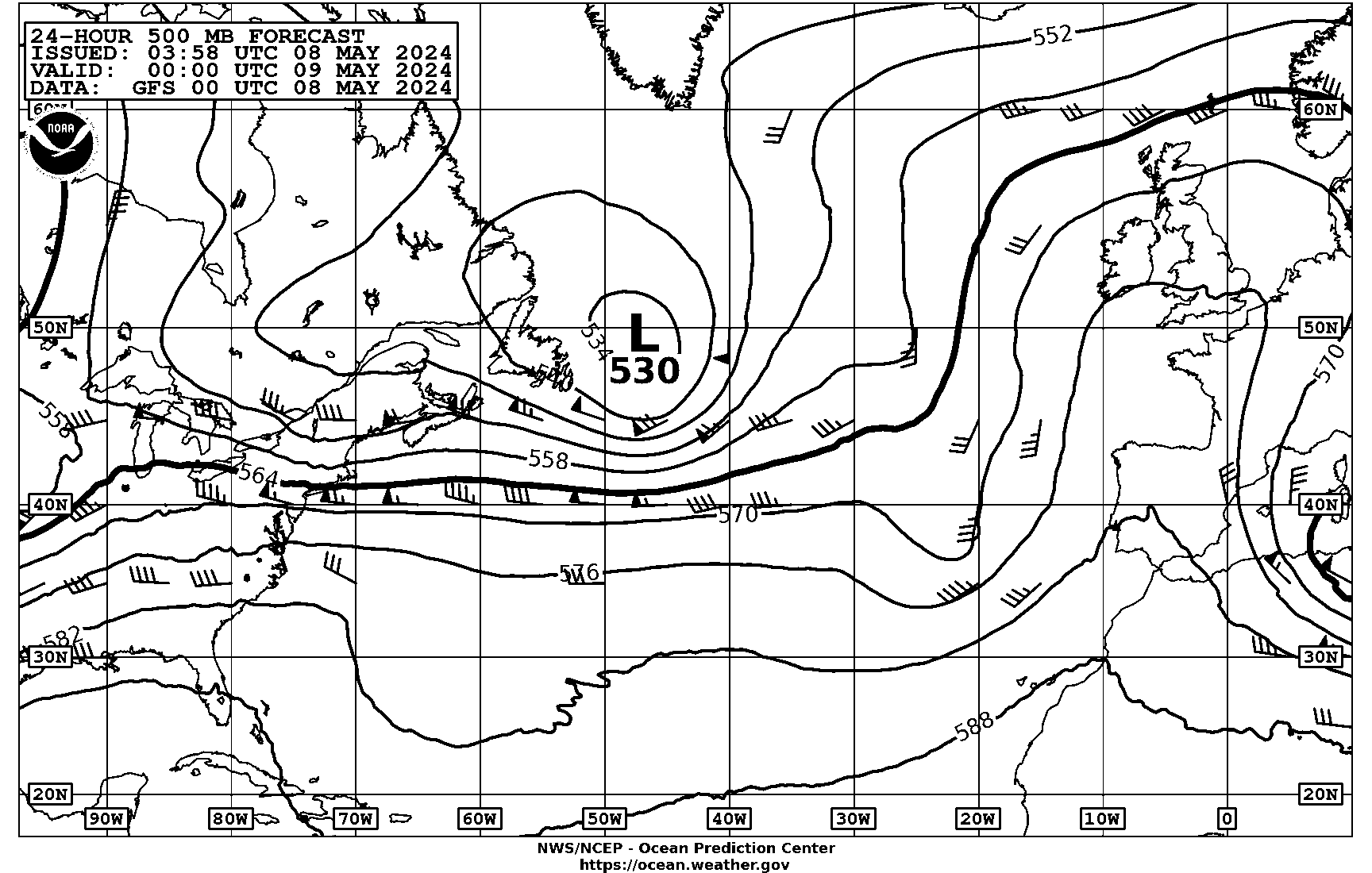
These forecasts generated twice a day at 00Z and 12Z for the regional Atlantic ocean are based on the latest numerical forecast model run. These products can be used to compare changes in flow patterns from the latest 500-mb analyses to follow the progression of short waves identified from the most recent 500-mb analyses. The 500-mb 24-Hour Forecasts can be used in conjunction with the Surface and Sea State 24-hour forecast products. Comparison or verification of previous 24-hour 500-mb Forecasts with the most current 500-mb analysis can establish confidence in subsequent forecasts.
36-Hour 500-mb Forecasts
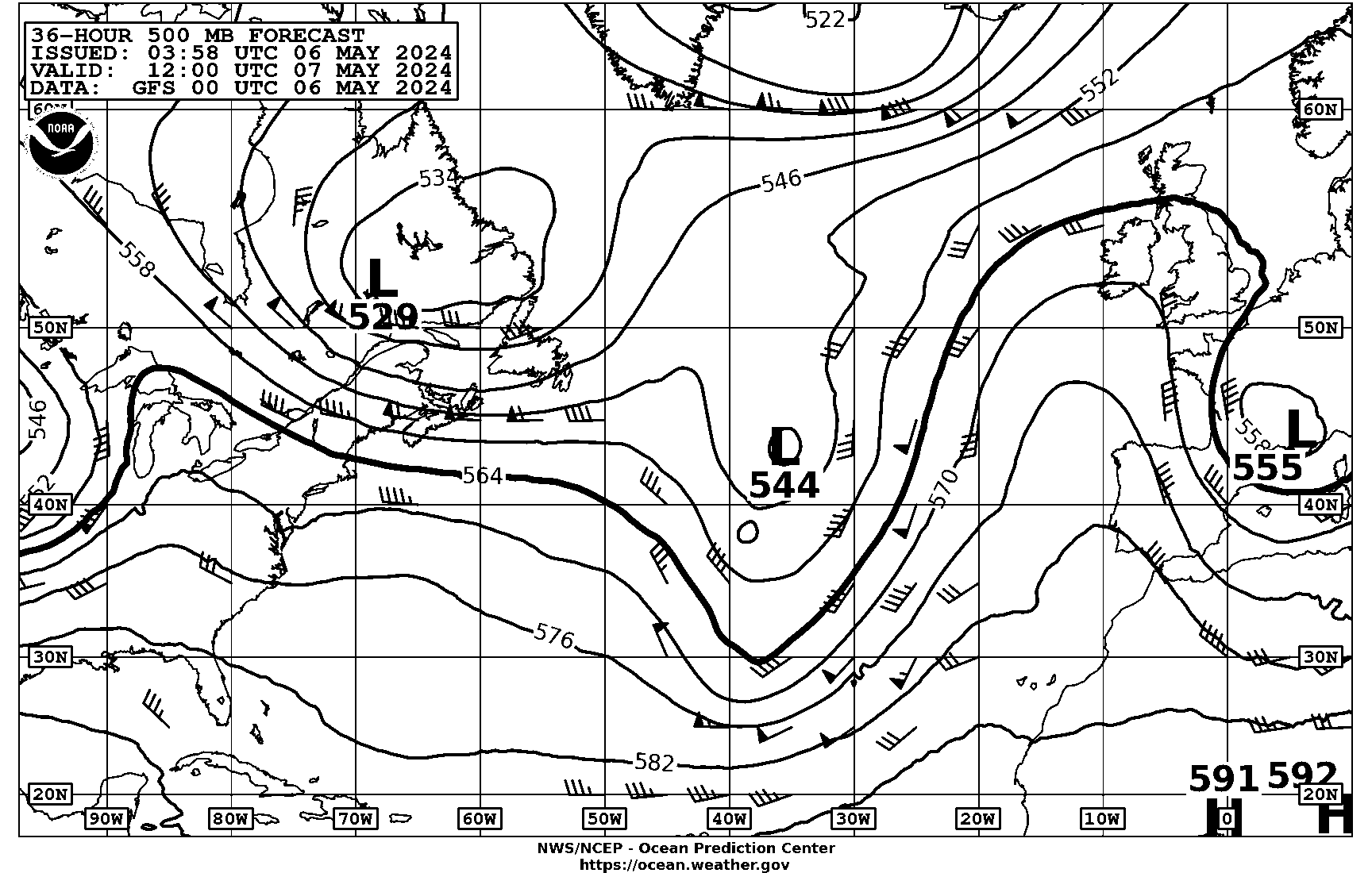
These forecasts generated twice a day at 00Z and 12Z for the Atlantic ocean are based on the latest numerical forecast model run. See 48-Hour 500-mb Forecast for further details.
48-Hour 500-mb Forecasts
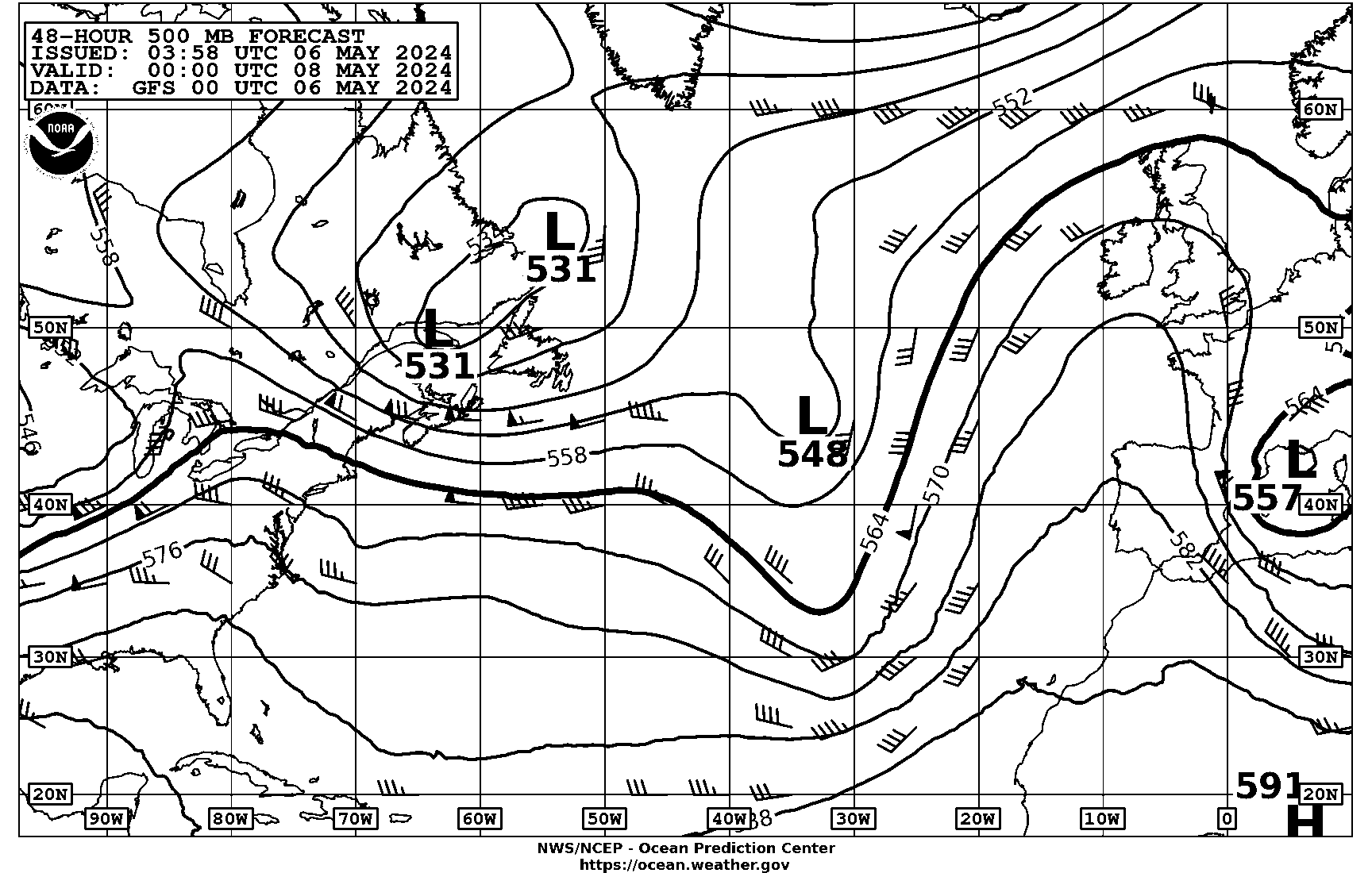
These forecasts generated twice a day at 00Z and 12Z for each ocean are based on the latest numerical forecast model run. These products can be used to compare changes in flow patterns from the latest 500-mb analyses to follow the progression of short waves identified from the most recent 500-mb analyses. The 500-mb 48-Hour Forecasts can be used in conjunction with the Surface and Wind/Wave 48-hour forecast products. Comparison or verification of previous 48-hour 500-mb Forecasts with the most current 500-mb analysis can establish confidence in subsequent forecasts.
96-Hour 500-mb Forecasts
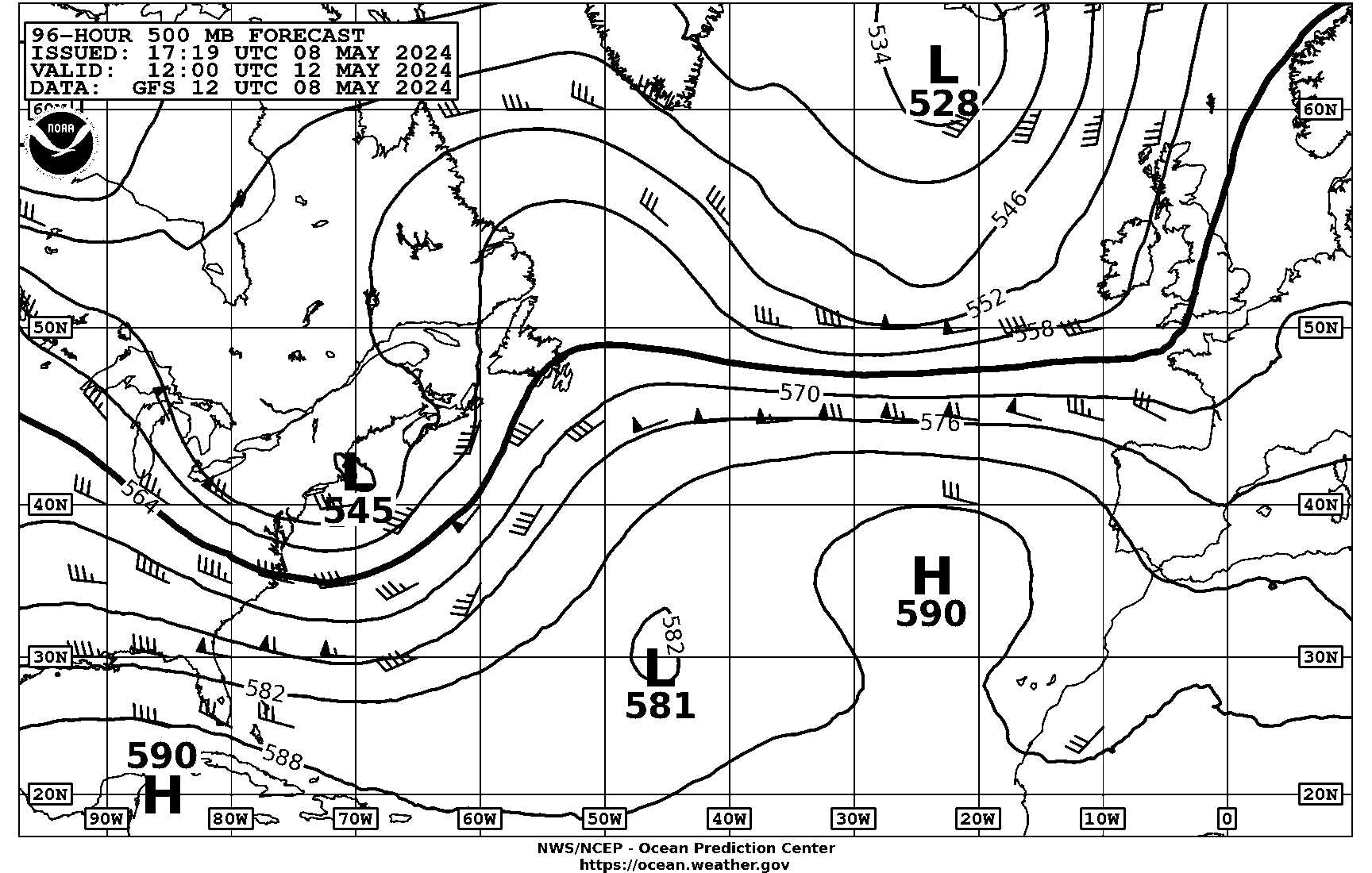
These forecasts are generated once a day at 12Z from the latest numerical model run. These products can be used to compare changes in flow patterns from the latest 48-hour 500-mb forecast to follow the progression of short waves identified from the most recent model guidance. The 500-mb 96-Hour Forecasts can be used in conjunction with the 96-hour Surface Forecast product.
Surface Products
These products include four surface analyses per day transmitted in two parts, two 24-Hour Surface Forecasts, two 48-Hour Surface Forecasts, one 72-Hour Surface Forecast, and one 96-hour Surface Forecast daily. The computer workstation aided surface analyses depict isobars, surface winds, frontal systems (occluded, stationary, cold, and warm), low and high pressure center positions, and central pressure. The leading edge of the ice edge is depicted as "black dots" and is typically found on the northern edge of the graphics. The 24 hour forecast position and central pressure are displayed for systems that are producing, or are expected to produce, "Gale Force" or higher conditions on all surface products. Systems having or expected to have synoptic scale "Gale", "Storm", or "Hurricane Force" conditions are labeled in bold capital letters. Similarly systems expected to develop "Gale", "Storm" or "Hurricane Force" conditions in 24 hours have labels of "Developing Gale" , "Developing Storm" or "Developing Hurricane Force". Surface low pressure falls of 24 mb or greater during a 24 hour period are denoted in large capital letters as "RAPIDLY INTENSIFYING".
Standard abbreviations:
DSIPT - DISSIPATE
STNRY - STATIONARY
WKNG - WEAKENING
RPDLY - RAPIDLY
FRMG - FORMING
MOVG - MOVING
INLD - INLAND
DVLPG - DEVELOPING
COMB - COMBINED
DCRS - DECREASE
INCRS - INCREASE
INTSFY - INTENSIFY
Q-STNRY - QUASI-STATIONARY
For further information on terms or abbreviations used on surface products see Key Terminology and Weather Symbols
For tropical cyclones, the alphanumeric description of the analyses or forecast time are displayed in bold capital letters adjacent to the tropical cyclone's position with the appropriate cyclone symbol.
TYPHOON or HURRICANE or TROPICAL STORM "NAME"
MAX WINDS___ KT G (GUST) ___KT
Mariners are strongly advised to rely on the latest warnings from the National Hurricane Center's, which covers the Atlantic and the Eastern Pacific Oceans east of 140W, and the Central Pacific Hurricane Warning Center (PHNL) covering the Eastern and Central Pacific Ocean west of 140W to the international dateline (180), and the Joint Typhoon Warning Center (JTWC), covering the Western Pacific west of 180.
The surface forecasts produced by our marine meteorologists are derived by comparing several U.S. and foreign government agencies forecast models. As a result of the blending of these different model solutions, the surface forecasts may not exactly coincide with the corresponding automated 500 mb forecasts.
Surface Analyses (Parts 1 & 2)

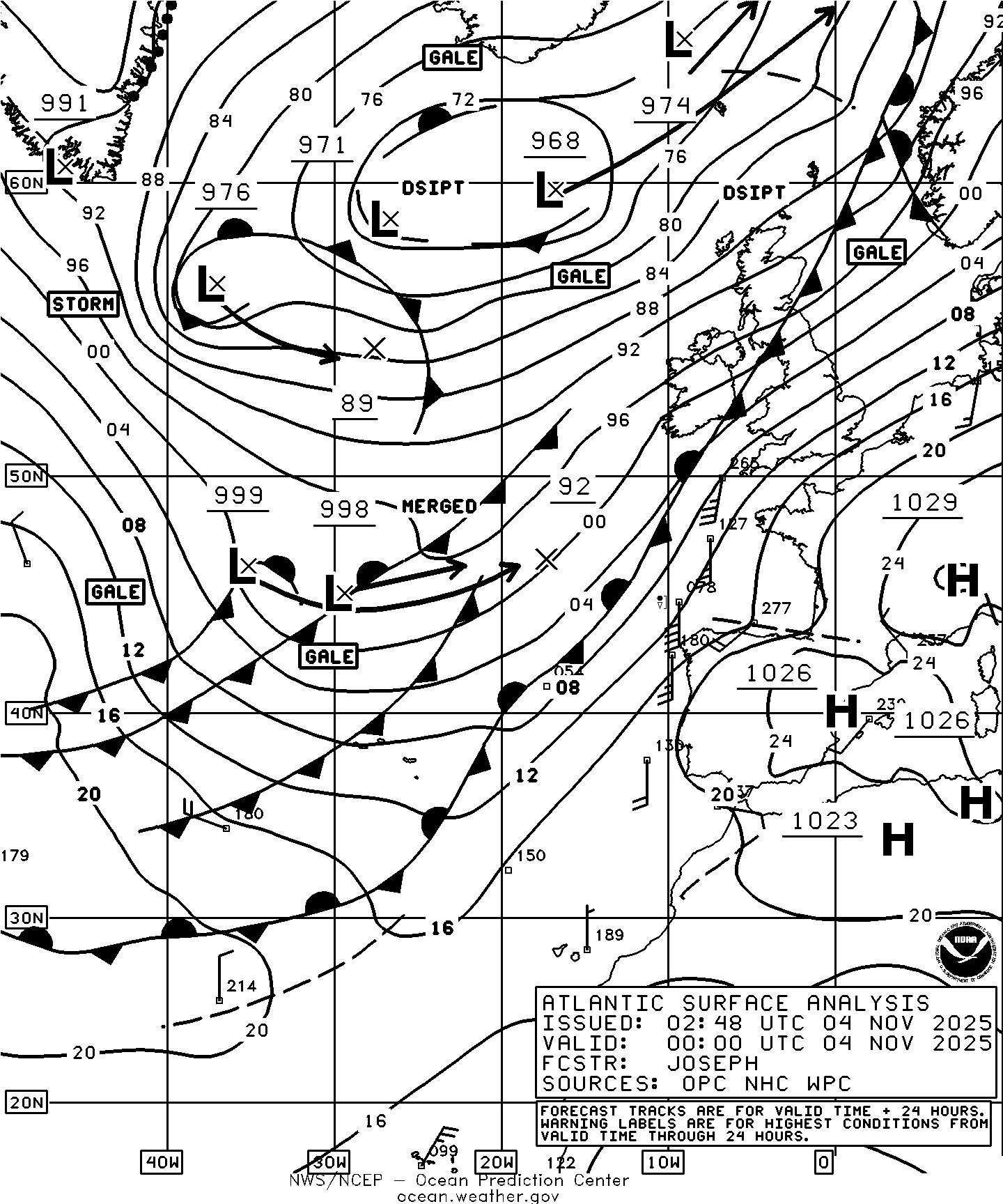
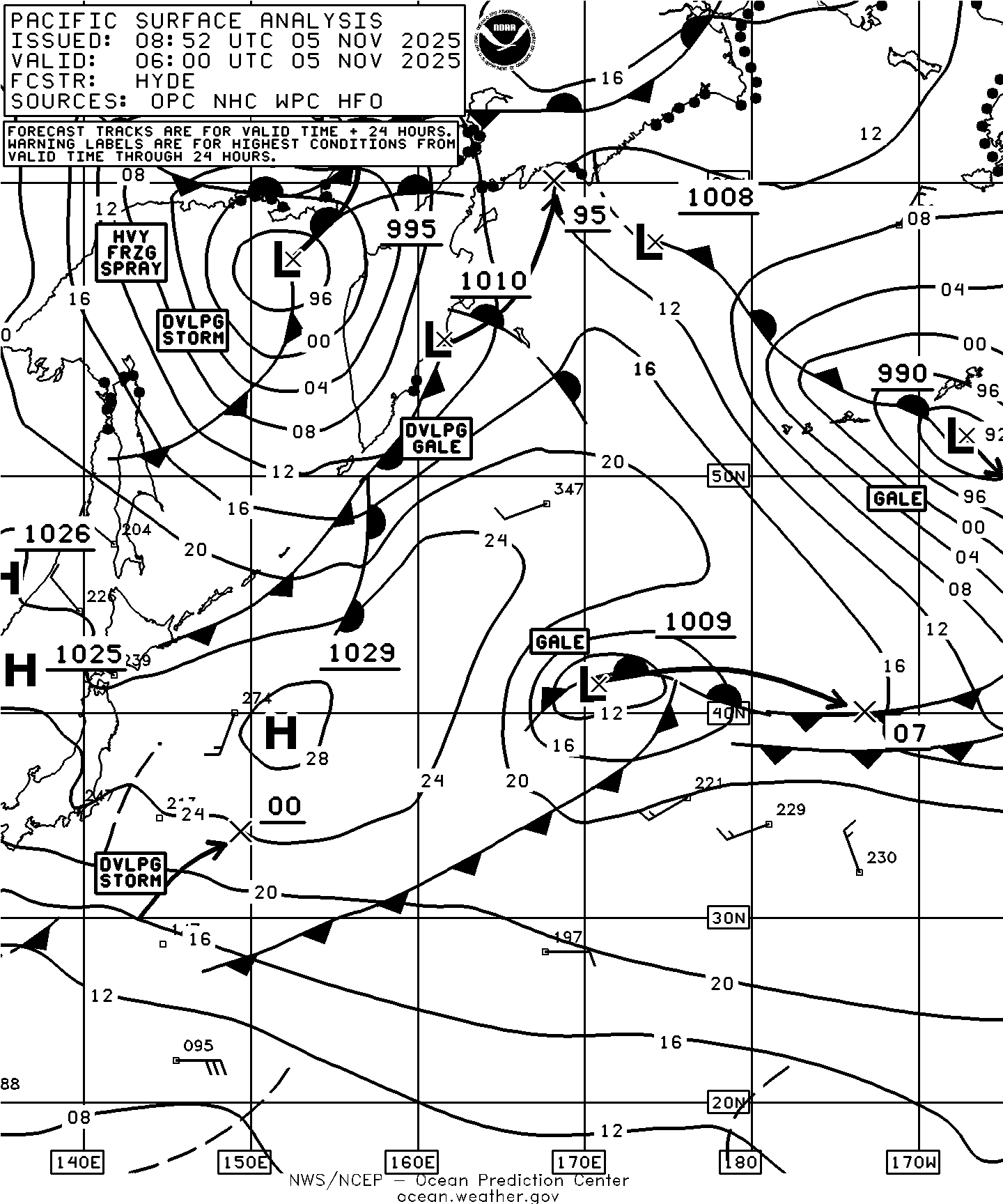
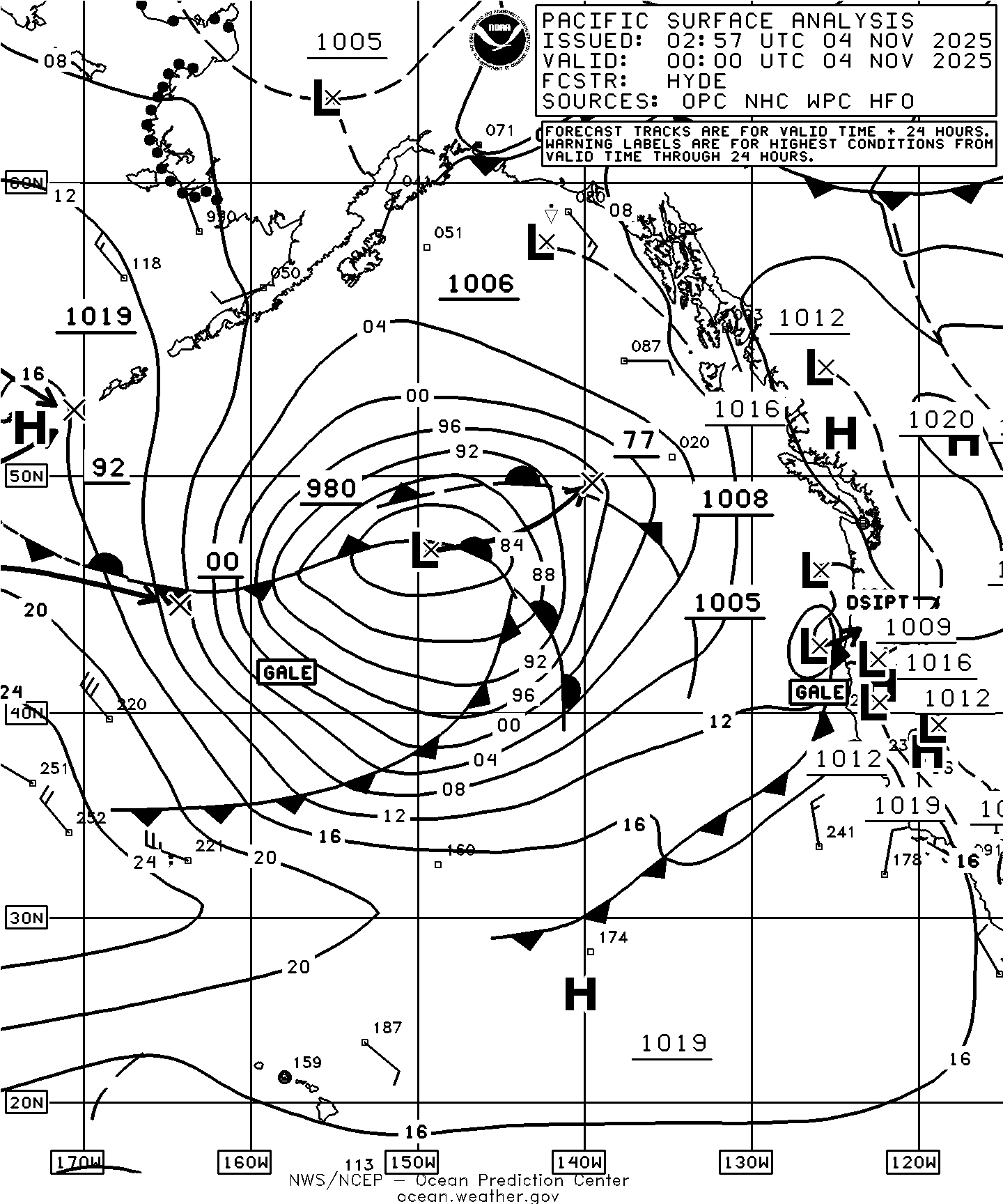
The surface analyses are generated four times per day (00Z, 06Z, 12Z, and 18Z) for each ocean. The analyses consist of isobaric pressure analyses at 4 mb contour interval spacing, labeled every 8 MB. The central pressure mb values of low and high pressure systems are depicted in bold 3 or 4 digits and underlined and placed adjacent to or under the "H" or "L". The surface analyses also consist of abbreviated automated ship plots of wind direction (8 points on the compass rose), wind speed (in knots) and present reported weather (using current standard symbols). The product is issued in two parts, which overlap by some 10 degrees of longitude. Both parts will project the low or high pressure system's forecast position by drawing an arrow to the 24-hour position labeled as an "X" for lows with warnings or developing warnings. A bold, underlined, two digit millibar central pressure value under or adjacent to the 24-hour position label (e.g.,1001 mb low would be written as a 01 and a 960 mb low would have 60). Significant weather systems have labels depicting whether the system has "gale", "storm" or "hurricane force" conditions as observed by ship and buoy observations, remote sensing satellite data from sources such as ASCAT, satellite, or computer model guidance. If 24 hour forecast gale, storm or hurricane force conditions are expected, the appropriate area has the label "developing gale", "developing storm" or "developing hurricane force". The surface analyses have been doubled in size and issued as a two part product to allow the mariner to use the surface analyses as a work chart. The mariner can also have the option to use the appropriate Parts 1 or 2 if operating only in that part of the ocean which will impact the vessel. The mariner can also compare the ship's current barometric pressure reading and Beaufort Wind Scale force conditions or anemometer readout of winds observed at the vessel to determine the product's validity. NOTE: It is difficult to determine the central pressures of tropical depressions, tropical storms, and hurricanes/typhoons, but an estimate or measurement will be provided by a hurricane specialist for the Atlantic and East Pacific. In the Pacific west of the dateline central pressure will likely not be provided nor will estimated pressures associated with these systems for forecast central pressure.
Mariners can then make their own inferences on how specific weather systems will impact their vessels. Used in conjunction with a 500 mb analysis, the 24 hour forecast position of synoptic scale weather systems will aid in determining a weather system's motion and intensity trends, thus extending the usefulness of the product. The surface analyses will also be broadcast in a very timely manner, less than 3 1/2 hours from the valid synoptic time. This product is an important tool that can substantially aid in the independent decision making process for crew safety, protection of the ship, prevention of cargo damage, and maintaining schedules.
48-Hour Surface Forecasts
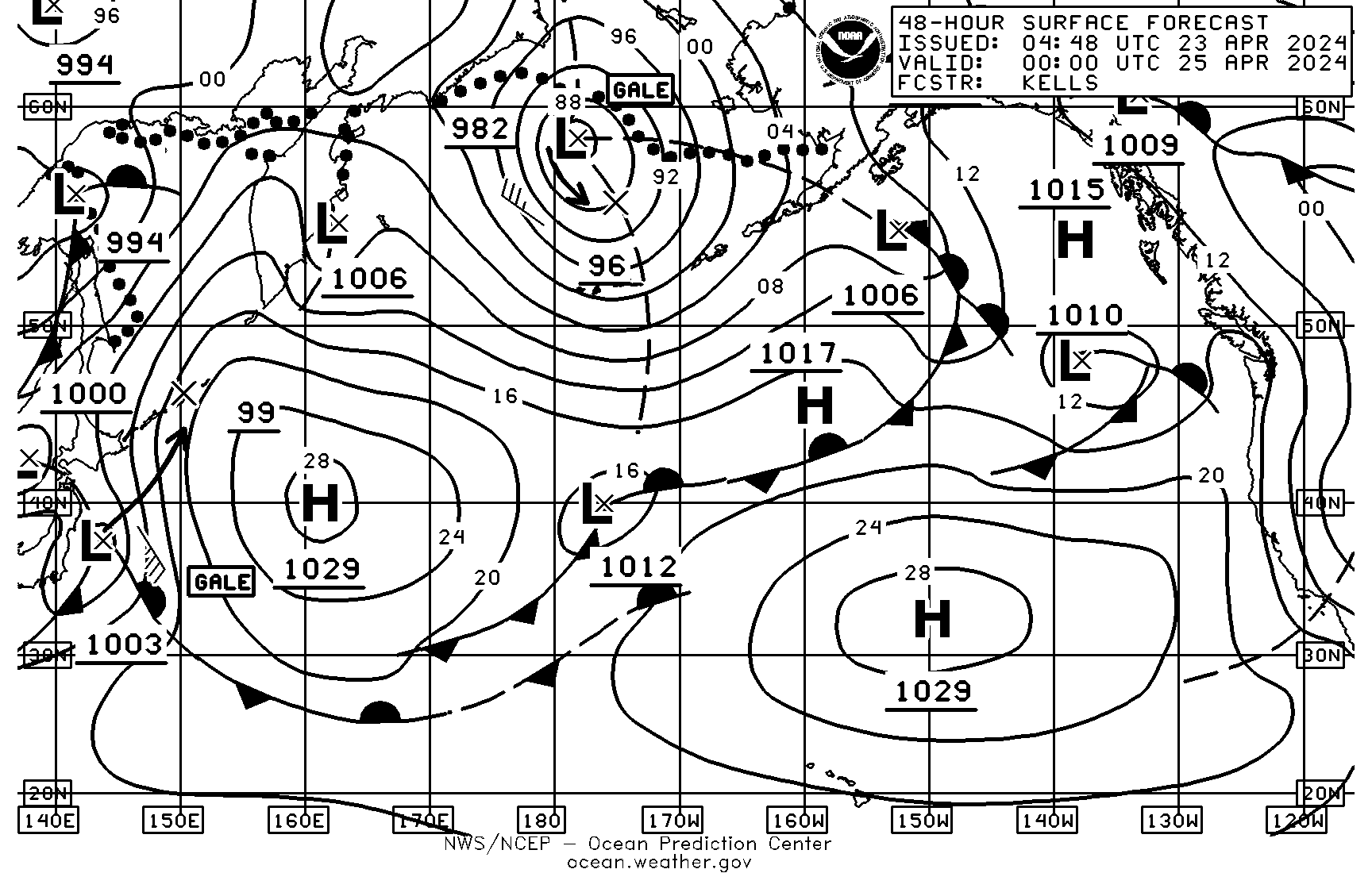
These surface forecast products generated twice each day for each ocean based on the 00Z and 12Z Global Forecast System (GFS) forecast model run outputs with additional guidance from other government agencies such as the NAVYs Navy Operational Global Atmospheric Prediction System (NOGAPS). Also, other foreign governments/university numerical model guidance is used such as the Canadian Regional(GEM), the United Kingdom UKMET, and the European (ECMWF) Model. The use of several numerical models allows adjustments to be made to the final forecast product. The products show surface isobars every 4 mb with labeling of 2 digits in increments of 8 mb. The central pressure millibar values of synoptic scale lows and highs in bold 3 or 4 digits are underlined adjacent to or under the "L" or "H". The future 72-hour forecast position of lows and highs have vector arrows with an "X" for low centers and a "circle with an X inside" by the head for high centers. An underlined bold two digit mb central pressure value will be placed under or adjacent to the 24/72 hour position label (e.g.,1050 mb high would be written as a 50 and a 960 mb low would have 60). The 48-hour surface forecast depicts wind speeds in knots (wind barbs in increments of 5 or 10 knots) for areas of wind in excess of 33 knots, and frontal systems (occluded, warm, and cold). Significant systems have labels depicting whether the system is expected to have "gale" , "storm" or "hurricane force" conditions. If 72 hour forecast gale, storm or hurricane force conditions are expected, the appropriate area has the label "developing gale" , "developing storm" or "developing hurricane force" . If a tropical system such as a hurricane or typhoon is anticipated the 48-hour position will be indicated as a "tropical symbol". The 72-hour position will correspond to the latest official forecast from the Joint Typhoon Warning Center (JTWC) or Central Pacific Hurricane Center (CPHC) in the Pacific or the National Hurricane Center (TPC) in Miami, Florida which has responsibilities in the Atlantic and Pacific. The very timely issuance of the 48-hour surface forecasts, when used in conjunction with the 48-hour 500 mb and wind/wave forecast products can help vessels make course and speed adjustments to avoid the heaviest forecast wind and wave conditions or minimize the ship's exposure to heavy weather. The tracking history and forecast projection of highs and low from 24 hours through 72 hours will serve to extend the time usage of the product, thus aiding a vessel's Master in the determination of crew safety, minimizing ship or cargo damage, fuel economy, and maintaining schedules.
96-Hour Surface Forecasts
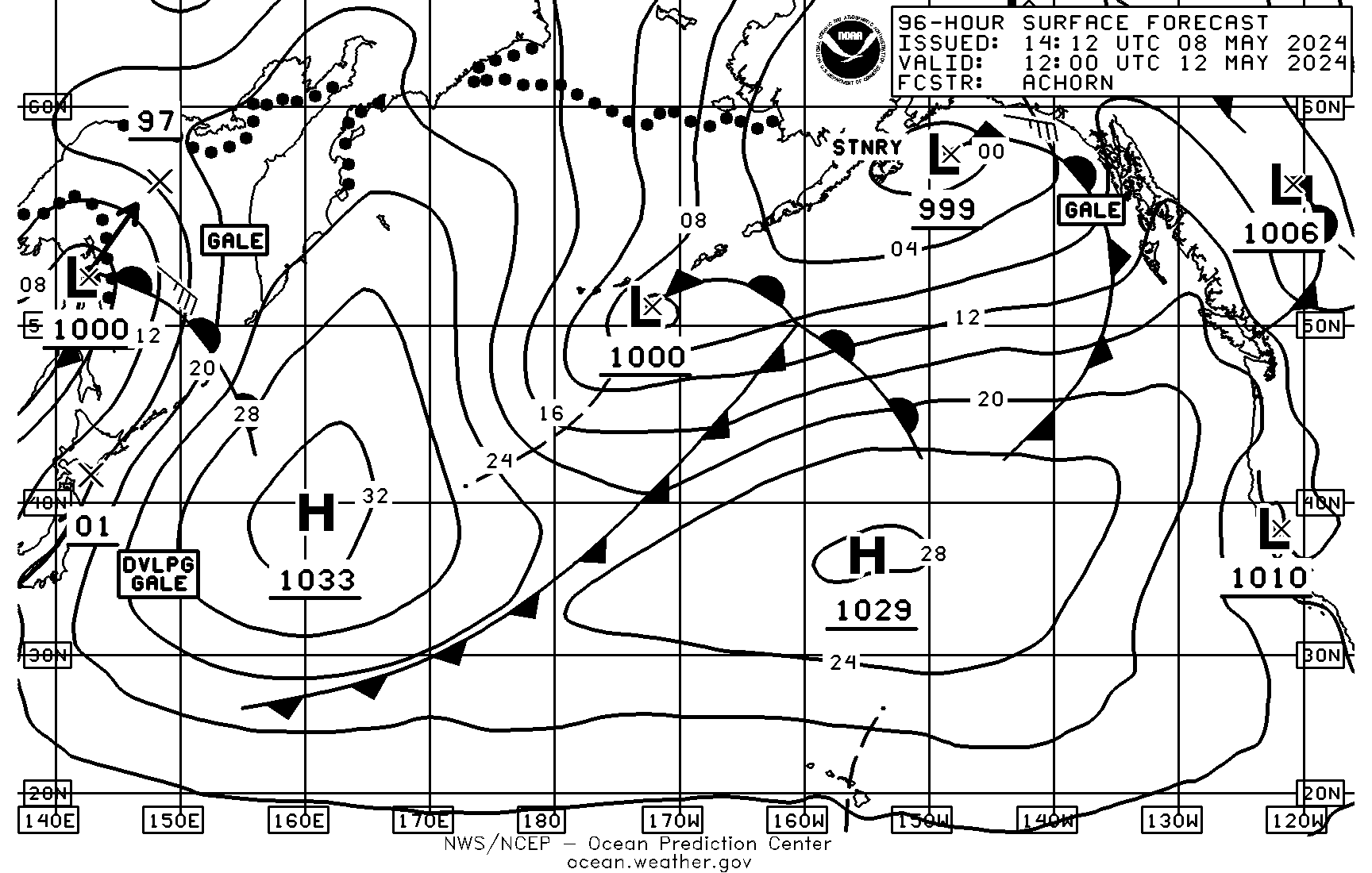
These extended surface forecast products are generated once each day. The product is based on the 12Z Global Forecast System (GFS) model for each ocean with additional guidance from other government agencies such as the Navy's Navy Operational Global Atmospheric Prediction System (NOGAPS). Also, other foreign goverments numerical model guidance is used such as the European Center for Medium Range Weather Forecasts (ECMWF) and Canadian Regional Model. The use of several numerical models allows adjustments to be made to the final forecast product. The products show surface isobars every 4 mb with labeling of 2 digits in increments of 8 mb. The central pressure millibar values of synoptic scale lows and highs in bold 3 or 4 digits are underlined adjacent to or under the "L" or "H". The 72-hour forecast position and future 120-hour forecast position of lows and highs have vector arrows with an "X" for low centers and a "circle with an X inside" by the head for high centers. An underlined bold two digit mb central pressure value will be placed under or adjacent to the 72/120 hour position label (e.g.,1030 mb high would be written as a 30 and a 980 mb low would have 80). The 96-hour surface forecast depicts wind speeds in knots greater than or equal to 34 kt (wind barbs in increments of 5 or 10 knots), and frontal systems (occluded, warm, and cold). Significant systems have labels depicting whether the system is expected to have "gale" , "storm" or "hurricane force" conditions. If by 120 hours forecast gale, storm or hurricane force conditions are expected, the appropriate area has the label "developing gale", "developing storm" or "developing hurricane force". If a tropical system such as a hurricane or typhoon is anticipated the 96-hour position will be indicated as a "tropical symbol" with the pressure as "XXX" for an unknown pressure. The 72-hour and 120-hour position will correspond to the latest official forecast from the Joint Typhoon Warning Center (JTWC) or Central Pacific Hurricane Center (CPHC) in the Pacific or the National Hurricane Center (TPC) in Miami, Florida which has responsibilities in the Atlantic and Pacific. The issuance of the 96-hour surface forecasts, when used in conjunction with the 96-hour 500 mb, can help vessels make course and speed adjustments to avoid the heaviest forecast wind conditions or minimize the ship's exposure to heavy weather. The tracking history and forecast projection of highs and lows from 72 hours through 120 hours will serve to extend the time usage of the product.
Sea State Products
One of the greatest hazards to a vessel's safety and seakeeping capability is having to maneuver around and through changeable sea state conditions. Masters have the awesome responsibility to make transoceanic crossings with crew safety the highest in priority and then ensuring that the ship and its valuable cargo arrive at destination ports safely while meeting tight schedules. The duration of adverse or slowing seas must be minimized since turn around time in each port is usually less than 24 hours. OPC issues one sea state analysis for both the Atlantic and Pacific oceans on a daily basis. The OPC issues two 48-Hour Wind/Wave Forecasts and one 96-Hour Wind/Wave Forecast each day. In addition two 48-Hour Period Forecasts and one 96-Hour Period Forecast are prepared each day. During the winter cold season, the ice edge is depicted as a black dotted line. The contours for these products is in one meter intervals with a relative maximum and minimum combined wave height values centrally displayed and inside a box. Forecast of all wind speeds is also depicted. The sea state forecast when viewed with the 48-hour surface forecasts will help vessels make course and speed adjustments to avoid hazardous conditions and minimize exposure to slowing conditions.
Sea State Analysis
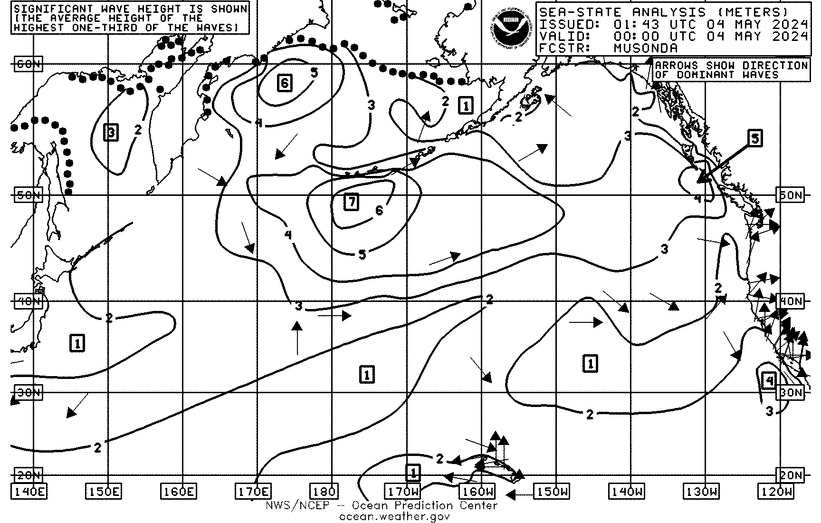

This product is once a day per ocean at 00Z for the North Pacific and 12Z for the North Atlantic with analysis of ship synoptic reports and automated weather stations such as CMANs for sea state in "meters". The sea state analysis is prepared for each ocean at the time of day when the greatest quantity of observations are taken. The sea state analysis has solid 1 meter contour intervals. Where appropriate, relative maxima and minima combined wave height values (approximately 1/3 the height of the wind wave added to the height of the swell wave) are centrally depicted and inside a box under or adjacent to the wave height value. To produce the final analysis ships and buoys reporting data along with the NCEP significant wave forecast models are used for guidance in areas of sparse data and are used to verify model guidance. The sea state analyses highlight where the most significant combined sea states prevail. Dominant wave direction arrows are also depicted. When viewed together with the surface analyses, the user should have a complete picture of surface weather conditions in a very timely manner, thus substantially aiding the mariner in crew safety and the protection of property.
48-Hour Wind & Wave Forecast
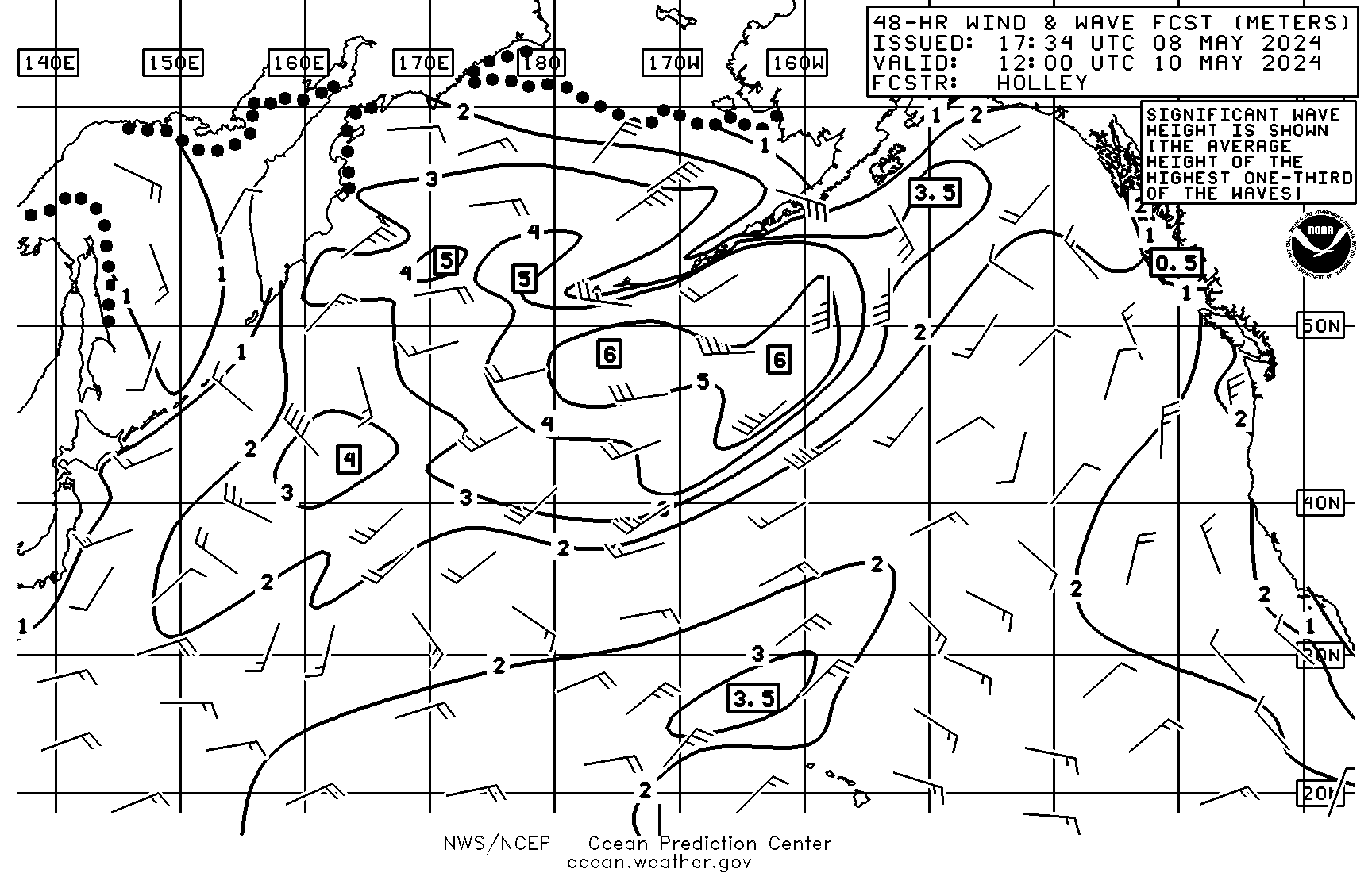
These forecast products are generated twice daily. The forecasts valid at 00Z and 12Z are based on the significant wave forecast model runs from NCEP WaveWatch. The combined sea heights are depicted in solid contours of one meter increments with relative maxima or minima combined sea state values enclosed inside a box under or adjacent to the area of interest. Also, the ice edge is displayed as a bold jagged line during the winter months. These products will provide a complete picture of forecast surface conditions when used in conjunction with the 48-hour surface forecasts. The 48-hour wind/wave forecasts highlight where the most significant combined sea heights prevail. Also, forecast wind speed in knots are plotted on this chart. The wind/wave forecasts products are issued in a timely manner and will significantly aid in the independent decision-making process of heavy weather avoidance, thus aiding vessels in minimizing the duration of encounter of slowing or potentially damaging conditions.
Areas of superstructure ice accretion, based on a specialized ice accretion model, are identified with a unique, internationally recognized, symbol. A bold line separates areas of moderate or greater from light or less.
48-Hour and 96-Hour Wave Period & Direction/Ice Accretion Forecast
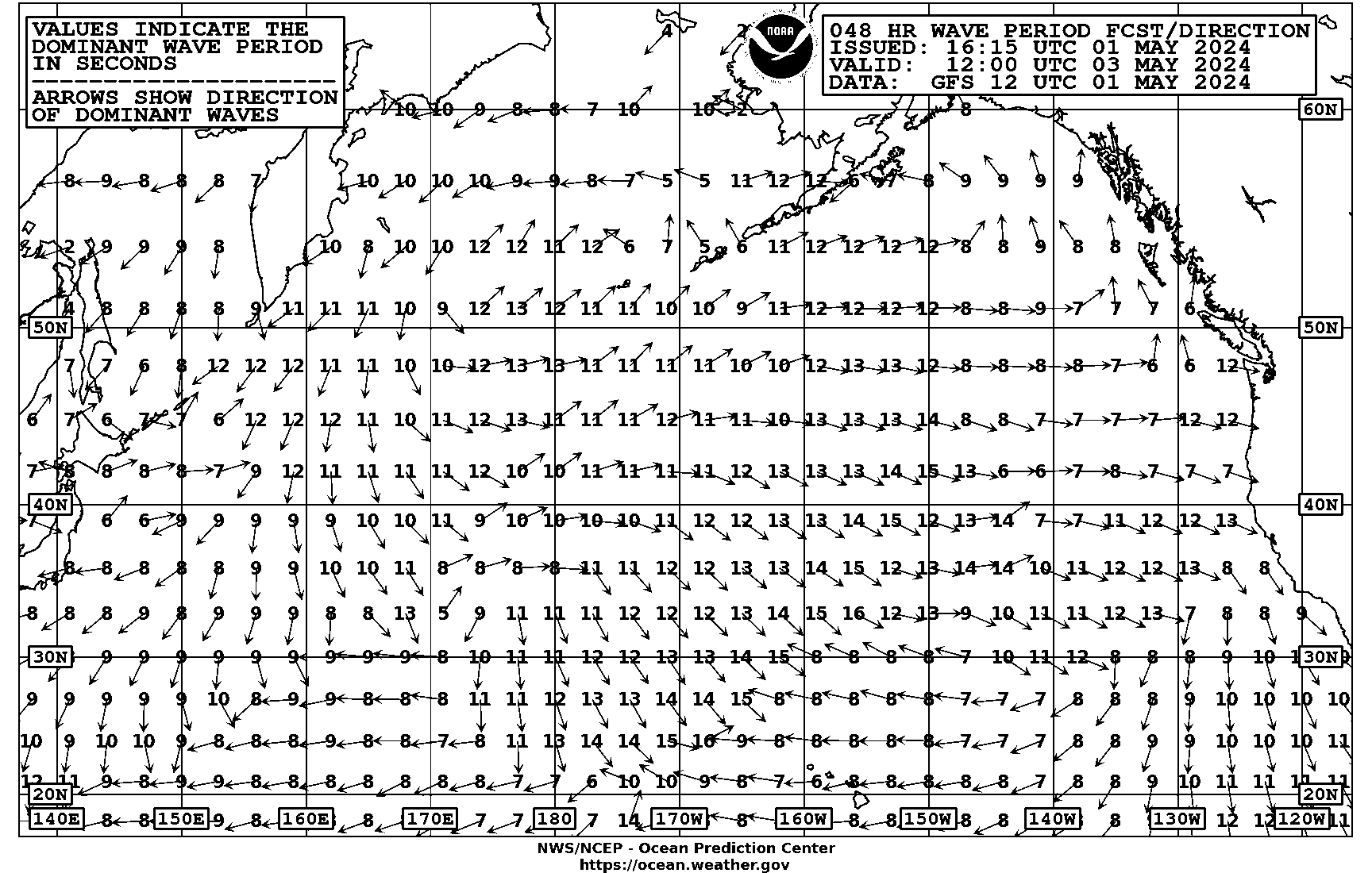
The graphic is generated twice a day from the 00Z and 12Z NCEP computer model runs for 48 hours and once a day from 12Z for 96 hours. The 48-hour and 96-hour graphics are automatically created.
The forecast relies on guidance from the NCEP WaveWatch with forecasts for the Atlantic and Pacific Oceans. The peak period identifies either the locally generated `wind sea' (in cases with strong local winds) or the dominant wave system (`swell') that is generated elsewhere. Note that the peak period values likely show discontinuities. These discontinuities can loosely be interpreted as swell fronts, although in reality many swell systems overlap at most locations and times. A swell front is the leading edge of wave periods with higher energy which typically originates and moves away from a storm center. Arrows on the forecast chart point toward the prevailing swell direction of propagation of the dominant wave system.
Regional Products
The regional surface graphic products target the coastal, offshore and high-seas users. These products produced on mercator map backgrounds encompass the western Atlantic Ocean west of 40W and north of 20N, including the US east coast and much of the Gulf of America. Also covered on the mercator projection is the eastern North Pacific Ocean, from the Baja peninsula, just south of Cabo San Lucas, and north to the Gulf of Alaska, including Prince William Sound as far west as 155W. On the polar stereographic map backgrounds which includes Alaska and covers the area from 40N to 70N and to as far west as 165E. The regional products consist of mercator sea state analysis and 24-hour forecasts of the mercator/polar stereographic surface and wind/wave. The Ocean Prediction Center issues the regional sea state analysis and forecast products several times daily per ocean for 00Z, 12Z, and other intermediate times. The sea state analysis shows ship observations with observed winds (knot) and sea state in feet. The short range forecast products depict synoptic and mesoscale features of surface low and high pressure systems and isobars with frontal features, areas of reduced visibility, wind speeds, and significant wave height as generated by the synoptic and mesoscale weather systems within 1000 miles of the U.S. east and west coasts. The process of product preparation includes using wind speeds derived from remote sensing satellite data from sources such as ASCAT polar orbiting satellite from oceanic areas. This high state of the art technology of data input represents a significant enhancement in analyzing wind conditions in the marine environment. ASCAT is especially noteworthy in data sparse areas where there are no ship or buoy reports. Remote sensed satellite data aids in short range prediction of the 24-hour forecast products by enabling marine meteorologists to compare initial data from forecast model output and making the necessary adjustments to the near term forecast solutions.
Regional Sea State Analysis
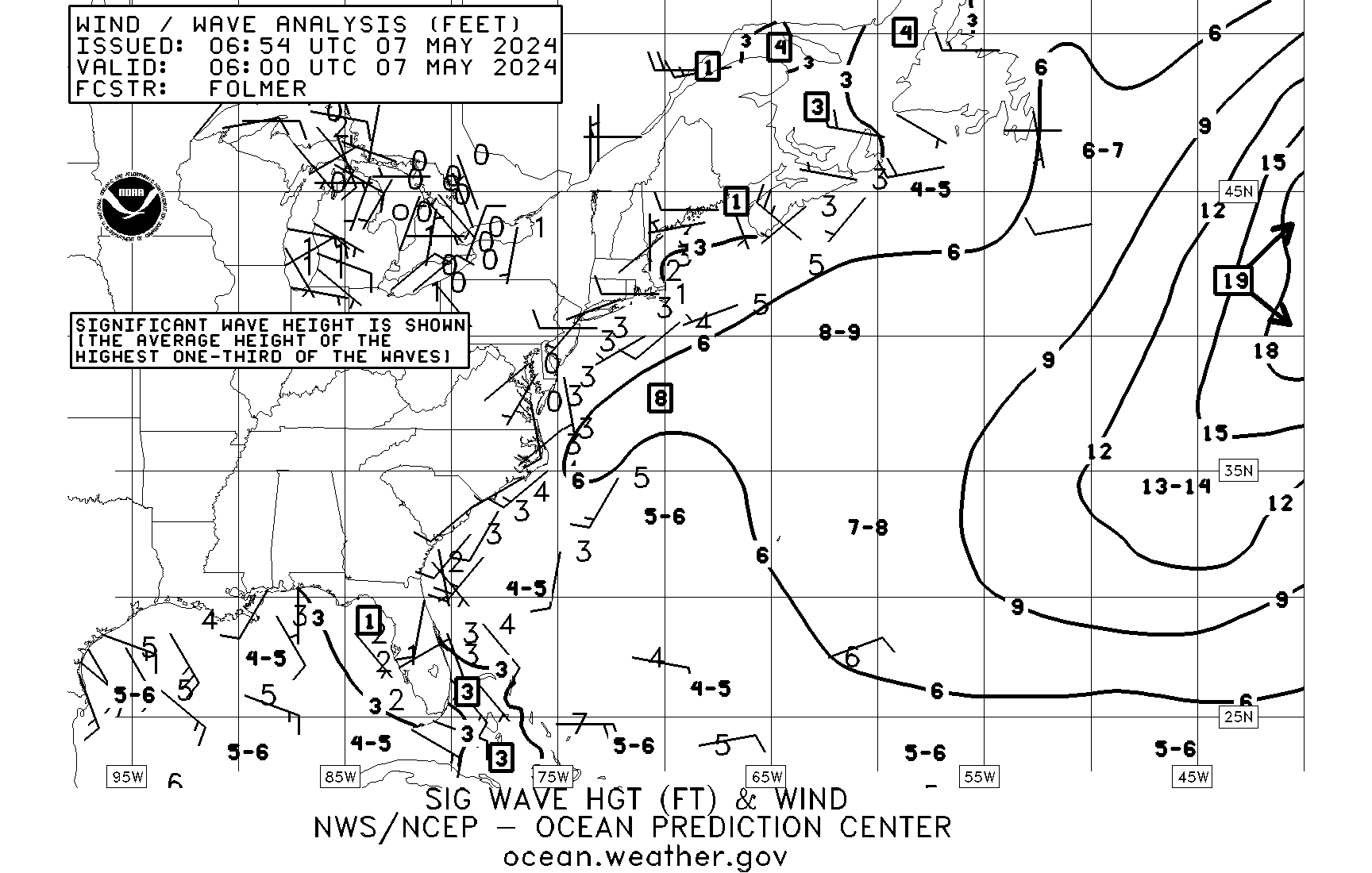

This product is issued every six hours for and is broadcast on the radiofacsimile program several times a day per ocean at 00Z, 12Z, and at some intermediate times, with analysis of ship synoptic reports and automated weather stations such as CMANs for sea state in "feet" and observed wind speed (knot). The sea state analysis has solid three foot contour intervals. Where appropriate, relative maxima and minima combined wave height values (approximately the highest 1/3 of wind waves and all swells) are centrally depicted and inside a box with the maximum or minimum values. To produce the final analysis ships and buoys reporting data along with the NCEP significant wave forecast models are used for guidance in areas of sparse data and are used to verify model guidance. The sea state analyses highlight where the most significant combined sea states prevail. When viewed together with the surface analyses, the user will have a complete picture of surface weather conditions in a very timely manner, thus substantially aiding the mariner in crew safety and the protection of property.
Oceanographic Products
Oceanographic Operational Products-Sea Surface Temperature (SST)
There are two ocean charts available on the Pacific Radiofacsimile program. Each of the charts is updated once a day with automated Sea Surface Temperature (SST) analyses derived from (IR) Infrared Satellite. The northern chart includes the nearshore waters of Washington and Oregon as well as the coastal waters of Vancouver Island and Queen Charlotte Sound in Canada; SST Analysis (40N-53N, east of 136W). The southern chart includes all of California, the Baja peninsula, and most of the coastal waters of western Mexico, south to near Puerto Vallarta; SST Analysis (23N-42N, east of 136W).

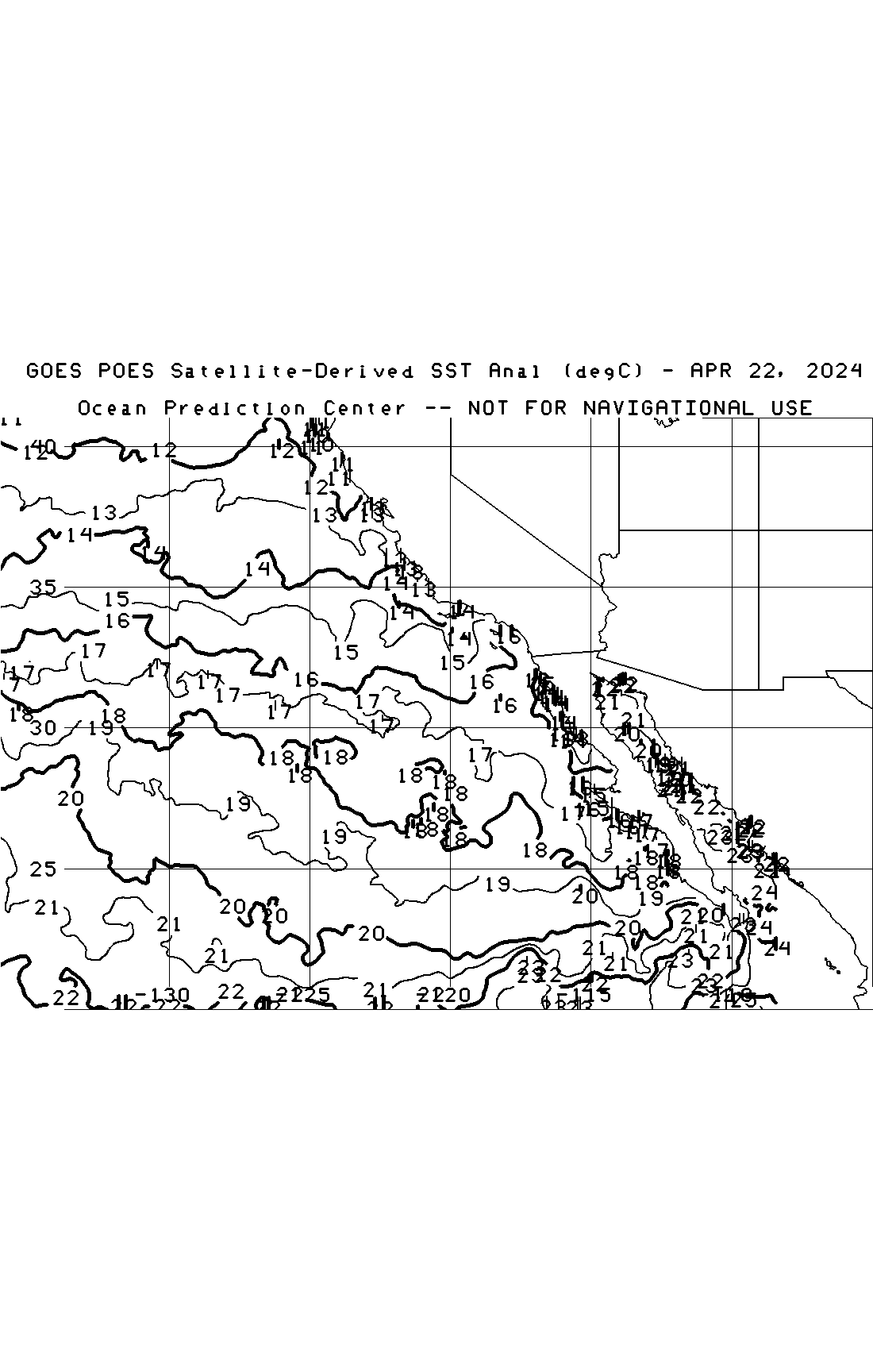
NOTE: Like weather charts, oceanographic charts depict operational data that are part of the total data set of the National Oceanic and Atmospheric Administration. The charts reflect a basic analysis of the data to support safe and efficient operations in the marine environment. If these products do not meet their specific operational requirements, users should consult the private meteorological and oceanographic community for further assistance.
Key Terminology and Weather Symbols (use this link to see OPC's terminology and symbols used on weather charts)
Ocean Prediction Center's OFB Radiofacsimile Schedule
The Atlantic and Pacific Radiofacsimile schedules list product times of transmission, request for comments on products, and product notice bulletins. During periods of lost or bad data, transmission problems, etc., information on the nature of the problem will be substituted for the scheduled product or substituted in the beginning of each broadcast cycle in place of the test pattern, as time and resources permit. If there are available time slots with the U.S. Coast Guard transmission schedule and lesser schedules priorities, and the U.S. Coast Guard agrees, every attempt will be made to rebroadcast the product. Most likely, the retransmission will occur at the end of the scheduled broadcast cycle.
National Hurricane Center's Radiofacsimile Program
The counterpart to the Ocean Prediction Center is the National Hurricane Center's Tropical Analysis and Forecast Unit which has responsibility for marine forecasts in the tropics and subtropics for the area S of 30N to the equator and E of 140W in the Pacific and S of 30N to the equator W of 35W in the Atlantic. The TAFB Radiofacsimile Program consists of two product suites: surface analysis products and marine forecast products. A east Pacific Wind/Seas Analysis (example 00Z [TIF|GIF]) is prepared by TAFB and is broadcast with forecast products from OPC through transmitters of the U.S. Coast Guard at Point Reyes, California. The graphic includes winds in knots and seas state values in feet. The chart also includes Tropical systems with the latest analyzed position and wind speed. Refer to the latest OPC Pacific Radiofacsimile schedule for transmission times and broadcast frequencies of this product.
For more information on the National Hurricane Center's TAFB Radiofacsimile program and its latest schedule please contact the National Hurricane Center by phone: (305)-229-4430, fax: (305)-553-1264, or website:
National Hurricane Center
11691 SW 17th St.
Miami, FL 33165-2149
Summary
In consultation with its users, OPC has designed a timely product suite of graphics and high seas marine warnings and forecasts. When displayed together and organized the charts provide the mariner with a complete meteorological and oceanographic picture. Prudent decision making dictates the mariner use all available information from as many sources as possible.
The OPC's Marine Radiofacsimile Charts and Warning Forecasts program is designed to assist mariners in making decisions regarding the protection of the crew from injury, prevention of ship and cargo damage, fuel economy, and meeting fixed schedules, as well as serving the commercial fishing and recreational communities. The product suite is based on user feedback and input, and is always subject to review and revision. We strongly encourage input from the marine user community.


